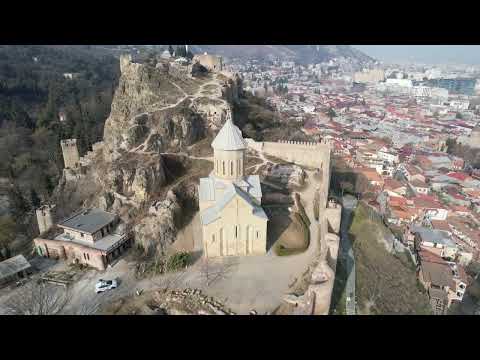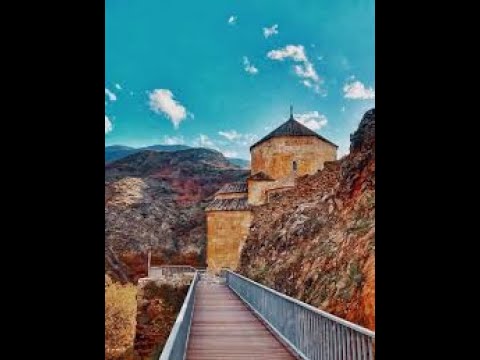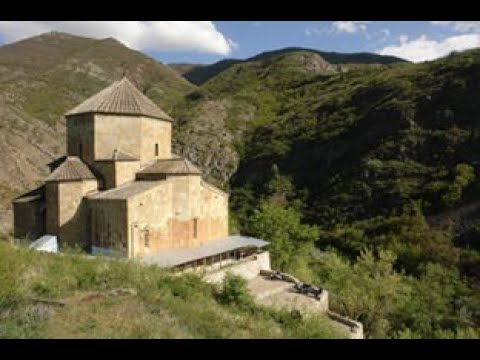ატენის სიონი / Ateni Sioni
Ateni sioni —The domed tetraconch cathedral of the I half of VII century. Located 12 km from Gori, Ateni Gorge, On the left shore of the Tana river.
Sioni is an early example of a "four-apse church with four niches" domed tetraconch (between the four apses are three-quarter cylindrical niches which are open to the central space), with entrance from the north. The dome tholobate rests om the three rows of tromps, transitioned to the four apses of the tetraconch. The lower tromp is eight-faceted, the middle sixteen- and the upper thirty-two-faceted. The church's cruciform interior measures 24m x 19.22m. Proportional space is perceived entirely, illuminated from the tholobate and apse windows. With restoration of the 10th century the upper parts of the church façades became faced with carved rectangular greenish-gray stones, while the lower still maintain original reddish color of the ashlar, richly decorated with ornaments and figurative reliefs. Position of the reliefs is, however, not well-organized, concentrated on the eastern façade, situated above the precipice and thus not easily observed. The restores reliefs are also more schematic. Original reliefs of the western façade depict deer hunting scene. Artist probably intentionally placed an empty ashlar to show distance of arrow flight. The hunter, riding a horse is dressed like rich person. He just shot an arrow, immediately piercing deer's neck. The other two deers look frightened. Another, shallower, relief is found on the tympanum above the northern entrance. Two deers are drinking from a rounded pool, and the water dynamism is depicted by circles. The relief symbolizes believers drinking from the same source of faith.
The church is not dated but is very similar in design to the Jvari Monastery at Mtskheta, which is generally held to have preceded it, and, hence, has been described by some art historians as belonging to the "Jvari-type" group of churches. Todosak, mentioned in an undated Armenian inscription on the southern facade as "I, Todosak, the builder of this holy church" is considered to have been an Armenian architect of the original church or its late 10th-century renovator.
The walls of the church contain numerous inscriptions inside and outside, among them the earliest known in Nuskhuri or Nuskha-Khutsuri, one of the versions of the early Georgian alphabet, dating from 835. The earliest known examples of Mkhedruli, a currently used Georgian script, are also found in the Ateni Sioni church and date to the 980s. Many inscriptions describe various historical events. One of the inscriptions on the church commemorates Adarnase I of Tao-Klarjeti, the first documented Georgian Bagratid nobleman who was the father of Ashot I, the founder of the new royal line of Georgia. Other inscription on the southern apse tells about the caliph, who got angry with Tbilisi emir Ishaq ibn Isma'il, sending a large troupe commanded by Bugha al-Kabir. Bugha defeated Ishaq's army and executed Ishaq himself, took over Tbilisi on August 5, 853 and burned the city. Another inscription on the southern facade tells about the King Bagrat IV, who ordered in 1060s to build a city in Ateni, listing all the constructed buildings. Ateni was eventually ruined.
Near the church there are the ruins of the medieval fortified town of Ateni (modern-day villages of Didi Ateni and Patara Ateni).
#Ateni
#Gori
#ShidaKartli
#Georgia
Lasha Mtvaradze-ის სხვა ვიდეოები

ლენტეხის მაცხოვრის ამაღლების ეკლესია / The Church...
 00:58
00:58
ჯვრის მონასტერი / Jvari Monastery
 02:03
02:03
ნინო წმინდას შინი, ფოკა
 00:16
00:16
ნარიყალას წმინდა ნიკოლოზის ეკლესია / Church of St....
 02:06
02:06
ნარიყალას წმინდა ნიკოლოზის ეკლესია / Church of St....
 00:54
00:54
ნარიყალას წმინდა ნიკოლოზის ეკლესია / Church of St....
 00:46
00:46
ნარიყალას წმინდა ნიკოლოზის ეკლესია / Church of St....
 00:46
00:46
ნარიყალას წმინდა ნიკოლოზის ეკლესია / Church of St....

მსგავსი ვიდეოები

ატენის სიონი / Ateni Sioni
Lasha Mtvaradze

ატენის სიონი / Ateni Sioni
Lasha Mtvaradze

ატენის სიონი / Ateni Sioni
Lasha Mtvaradze

ატენის სიონი / Ateni Sioni
Lasha Mtvaradze

ატენის სიონი / Ateni Sioni
Lasha Mtvaradze
![Atenis Sioni - ატენის სიონი [4K]](https://i.ytimg.com/vi/BAtfIeoQ0zg/hqdefault.jpg?sqp=-oaymwEbCKgBEF5IVfKriqkDDggBFQAAiEIYAXABwAEG\u0026rs=AOn4CLDa4rczCL6uflpDdbBXMvANUfarKw)
Atenis Sioni - ატენის სიონი [4K]
Enjoy Georgia

ატენის სიონი, atenis Sioni
Best of Georgia

Ateni Valley Georgia - TRAVEL Where You Live | იმოგზაურე სად...
TRAVEL With Us